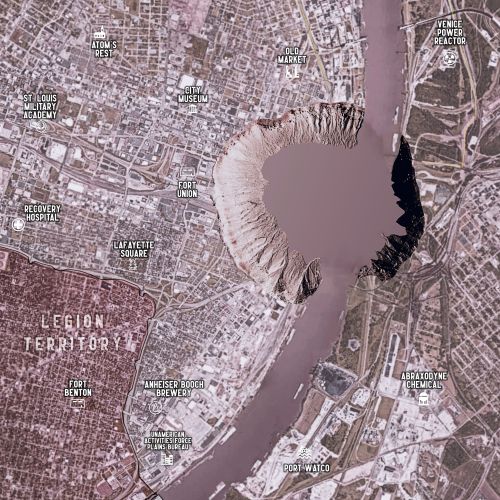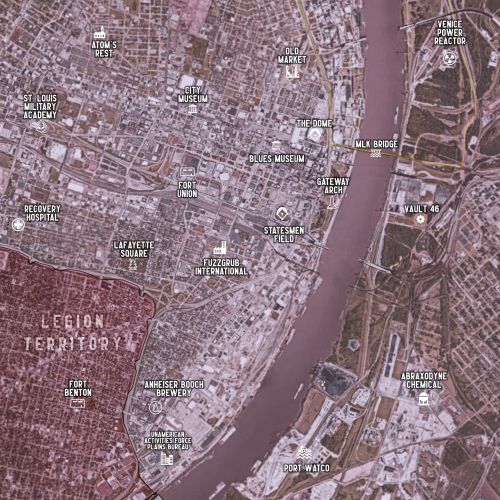St. Louis
St. Louis is a city at the confluence of the Mississippi and Missouri Rivers. Most of the city is occupied and defended by the Midwest Brotherhood of Steel, an area that enjoys an autonomous civilian leadership, but the southwest portion of the city is under the harsh rule of Caesar's Legion. The area recently came under nuclear attack from unknown assailants (SESSION 02: THE ST. LOUIS SUMMIT) and much of the downtown core was destroyed. The rest of the city is now bathed in heavy radiation that will not dissipate for hundreds of years.
When the Great War came in 2077, the city was destroyed by a nearby nuclear impact, leaving most of its buildings destroyed, its bridges downed and its land irradiated. Fewer than 1 in 10,000 survived. For nearly a century the entire population of St. Louis consisted of about two hundred desperate survivors huddled within The Dome, a covered sports stadium.
In 2196, a former Brotherhood of Steel Paladin, calling himself Gammorin, entered the area with an army of super mutants. The bulk of his force moved on, seeking the robotic army of The Calculator. But Gammorin left a contingent behind, who built an elaborate fortification on the banks of the Missouri River. A year later, the Midwestern Brotherhood entered the area, warring with the super mutants in violent clashes. The St. Louis base was overrun by Brotherhood knights and its super mutants taken captive. The Brotherhood would go on to defeat Gammorin and conscript the defeated super mutants into their army. By 2198, The Calculator was destroyed and the drafted supe rmutants were offered honourable discharge from military service. Many opted to stay in the Brotherhood, while others shifted to civilian life. The majority of these peaceful super mutants chose to settle in the south of St. Louis. A contingent of these veterans lives there to this day, operating the Anheiser Booch Brewery. Booch of the village of Emancipation is one of these super mutants.
The peace that followed The Calculator War allowed St. Louis to slowly grow. Small tribes of wastelanders from around the Midwest came to the city to trade and seek employment. The area has welcomed waves of refugees from the various wars to the east and south.
Though it was generally understood that the Midwest Brotherhood claimed territory as far south as pre-war Arkansas, the generals in Chicago never sought a formal agreement with other factions, nor did they raise any fortifications in southern Kansas or Missouri. In 2294, Caesar Aurelian Resitutor called the Brotherhood's bluff, annexing much of the Midwest at the same time they warred with Dixie. It was prayed for in the cities of Dixie that the Midwest Brotherhood would declare war in defence of this territory, but instead the Brotherhood made peace with Caesar. When the Legion/Dixie war ended with the Nola Miracle, the borders between the Legion and the Brotherhood were formally declared. In St. Louis, this meant that the Brotherhood would keep the majority of the city, but the Legion carved out the southwest corner, west of highway 55 and south of highway 44. The Legion constructed a great barracks at Fort Benton and constructed a 22-mile long vallus wall to mark the border, stretching from the Mississippi River to the Missouri River.
Despite the tension, the city has spent the past 23 years in peace. A significant amount of trade passes through St. Louis, both by the Mississippi River and the busy Interstate 70 highway system. The population has climbed to over 6,000 - the third largest city in the Midwest Brotherhood (next to Chicago and Twins.)
Notable Places
Gateway Crater Lake: The nuclear attack on the St. Louis Summit (See: SESSION 02: THE ST. LOUIS SUMMIT) left a crater that was filled by the Mississippi River. Vault 46 is under this water somewhere.
SLAMS: Once the pride of the Midwest Brotherhood of Steel, the St. Louis Academy of Military Sciences trained the Brotherhood's elite in battlefield tactics. But since the attack, the school has been abandoned and no replacement academy has been established.
Anheiser Booch Brewery: For 120 years, the super mutants of St. Louis have used this pre-war brewery to make the much-coveted Cavern Lager.
Atom's Rest: Atom's Rest is a hospice operated by the Children of Atom religion. Clients can request assisted suicide via intense radiation exposure, though the procedure is sometimes denied, based on the judgement of the local Confessor. Since the attack, the site has been consecrated by the High Confessor in Holy Toledo.
City Museum: Once St. Louis's premiere art museum, the building was completely looted and vandalized by survivors soon after the Great War. When the super mutant leader Gammorin came to this city, he mourned the loss of the artworks and commissioned super mutants to paint the bare walls in bright colours. To this day, the super mutants treat the wall paintings with reverence.
Old Market: The plaza at 13th and Tucker is still used as a marketplace, but only by those resistant to the area's radiation.
LaFayette Square: St. Louis 's oldest park, LaFayette square is now a scorched field of shadow and ash.
Recovery Hospital: This well-equipped facility was mostly abandoned after the attack. A small cadre of ghouls and robots remain to offer medical treatment.
Unamerican Activities Force, Plains Bureau: In the pre-war era, the Unamerican Activities Force served as a civilian intelligence service and secret police force, responsible for routing out potentially subversive or disloyal persons. The offices did not survive the Great War, but it is said the building still contains computers, hi-tech devices and millions of pre-war documents.
Port Watco: Port Watco was a large commercial port and wharf system, used to facilitate the industrial needs of East St. Louis. The Midwest Brotherhood of Steel had rebuilt the facility, but the nuclear attack has rendered it unusable.
Abraxodyne Chemical: Before the war, Abraxodyne was a successful chemical corporation, producers of the wildly popular Abraxo cleaner. Their East St. Louis superplant stands mostly in ruins, but still yields rare chemicals for knowledgeable scavengers.
Venice Power Reactor: A nuclear reactor and power plant built soon before the Great War, the Venice Power Reactor was used by the Midwest Brotherhood of Steel to charge fusion cores, but the facility is currently offline.
.
History
When the Great War came in 2077, the city was destroyed by a nearby nuclear impact, leaving most of its buildings destroyed, its bridges downed and its land irradiated. Fewer than 1 in 10,000 survived. For nearly a century the entire population of St. Louis consisted of about two hundred desperate survivors huddled within The Dome, a covered sports stadium.
In 2196, a former Brotherhood of Steel Paladin, calling himself Gammorin, entered the area with an army of super mutants. The bulk of his force moved on, seeking the robotic army of The Calculator. But Gammorin left a contingent behind, who built an elaborate fortification on the banks of the Missouri River. A year later, the Midwestern Brotherhood entered the area, warring with the super mutants in violent clashes. The St. Louis base was overrun by Brotherhood knights and its super mutants taken captive. The Brotherhood would go on to defeat Gammorin and conscript the defeated super mutants into their army. By 2198, The Calculator was destroyed and the drafted supe rmutants were offered honourable discharge from military service. Many opted to stay in the Brotherhood, while others shifted to civilian life. The majority of these peaceful super mutants chose to settle in the south of St. Louis. A contingent of these veterans lives there to this day, operating the Anheiser Booch Brewery. Booch of the village of Emancipation is one of these super mutants.
The peace that followed The Calculator War allowed St. Louis to slowly grow. Small tribes of wastelanders from around the Midwest came to the city to trade and seek employment. The area has welcomed waves of refugees from the various wars to the east and south.
Though it was generally understood that the Midwest Brotherhood claimed territory as far south as pre-war Arkansas, the generals in Chicago never sought a formal agreement with other factions, nor did they raise any fortifications in southern Kansas or Missouri. In 2294, Caesar Aurelian Resitutor called the Brotherhood's bluff, annexing much of the Midwest at the same time they warred with Dixie. It was prayed for in the cities of Dixie that the Midwest Brotherhood would declare war in defence of this territory, but instead the Brotherhood made peace with Caesar. When the Legion/Dixie war ended with the Nola Miracle, the borders between the Legion and the Brotherhood were formally declared. In St. Louis, this meant that the Brotherhood would keep the majority of the city, but the Legion carved out the southwest corner, west of highway 55 and south of highway 44. The Legion constructed a great barracks at Fort Benton and constructed a 22-mile long vallus wall to mark the border, stretching from the Mississippi River to the Missouri River.
Despite the tension, the city has spent the past 23 years in peace. A significant amount of trade passes through St. Louis, both by the Mississippi River and the busy Interstate 70 highway system. The population has climbed to over 6,000 - the third largest city in the Midwest Brotherhood (next to Chicago and Twins.)
Notable Places
.
Maps
-
St. Louis (Post-Summit)
St. Louis after nuclear attack at the St. Louis Summit (SESSION 02: THE ST. LOUIS SUMMIT) The divided city of St. Louis, held by the Midwest Brotherhood of Steel, except for the SW corner which is held by Caesar's Legion. -
St. Louis (Pre-Summit)
Before the nuclear attack at the St. Louis Summit (SESSION 02: THE ST. LOUIS SUMMIT) The divided city of St. Louis, held by the Midwest Brotherhood of Steel, except for the SW corner which is held by Caesar's Legion.
Type
City
Related Reports (Primary)
Related Reports (Secondary)





Comments